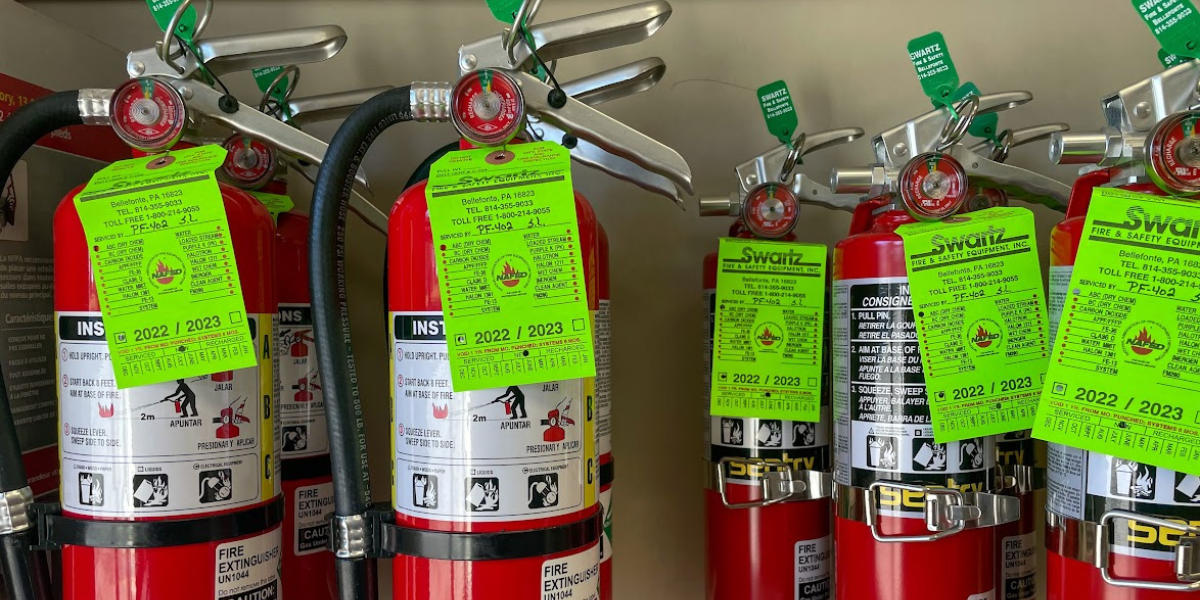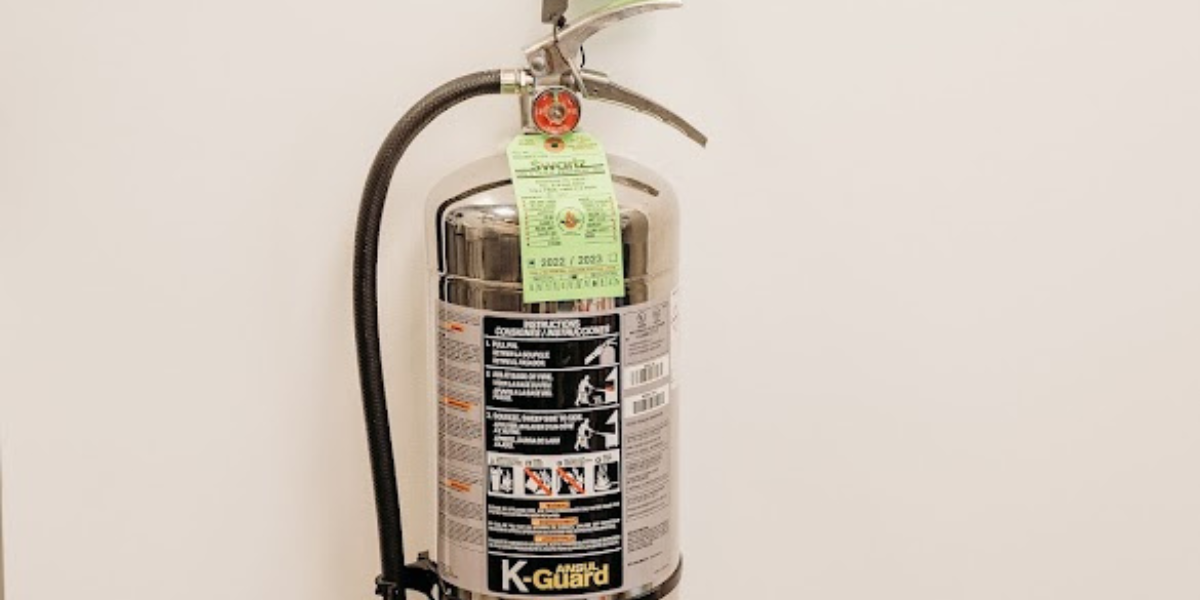A Comprehensive Guide to Fire Extinguisher Types A, B, C, & D

Not all fires burn the same way, and not all fire extinguishers put them out safely. Spraying water on an electrical fire can make it worse. Using the wrong extinguisher on burning fuel can spread the flames. Knowing the fire extinguisher types (A, B, C, & D) helps you act fast and stay safe.
Fire extinguishers are labeled by the kind of fire they fight. Each type is designed for specific materials, from wood and fabric to flammable liquids and live electrical equipment. A little knowledge can go a long way in preventing small fires from turning into major emergencies.
This guide will explain each fire extinguisher class and explain what it's used for and when to reach for it.
Key Takeaways
- Different fire extinguisher classes are designed for specific types of fires, and using the wrong one can make a fire worse.
- Multi-class extinguishers like ABC fire extinguishers offer versatile protection for homes and businesses.
- Regular maintenance, proper training, and strategic placement of extinguishers improve fire safety and emergency preparedness.
The Different Fire Extinguisher Classes
Fire extinguishers are categorized based on the type of fire they are designed to fight. The fire extinguisher types A, B, C, & D each target different materials and hazards, so it's absolutely crucial to choose the right one for the situation.
- Class A fire extinguishers handle common combustibles like wood, paper, cloth, and trash. These fires are the most common in homes and offices.
- Class B fire extinguishers are made for flammable liquids such as gasoline, oil, grease, and other fuels. These fires spread quickly and require extinguishers that can smother the flames.
- Class C fire extinguishers are designed for electrical equipment and energized electrical equipment like appliances, wiring, and power tools. Water-based extinguishers should never be used on these fires due to the risk of electrocution.
- Class D fire extinguishers put out combustible metals such as magnesium, titanium, and sodium. These fires are typically found in laboratories and industrial settings.
Fire extinguishers are labeled to indicate the types of fires they can fight, making it easier to choose the right one. Some are multi-purpose, like ABC fire extinguishers, which are effective against Class A, B, and C fires commonly found in homes and businesses.
Class A Fire Extinguishers for Everyday Fires
Class A fire extinguishers are designed for fires involving ordinary combustibles like wood, paper, cloth, and other common materials. These fires are the most frequent in homes, offices, and schools, making this extinguisher a must-have in everyday settings.
Best extinguishing agents
- Water fire extinguishers cool the flames and prevent reignition.
- Foam extinguishers smother the fire while also providing cooling effects.
- Dry chemical extinguishers work by cutting off the fire's oxygen supply, making them effective for a quick response.
Class A fires are among the easiest to control with the right extinguisher, but using other extinguishers meant for flammable liquids, electrical equipment, or combustible metals won't work on these materials.
Class B Fire Extinguishers for Flammable Liquid Fires
Class B fire extinguishers are built for fires involving flammable liquids like gasoline, oil, grease, and certain chemicals. These fires spread fast and require extinguishing agents that cut off oxygen and prevent reignition.
Best extinguishing agents
- Foam extinguishers create a barrier that smothers the flames.
- Carbon dioxide extinguishers (CO₂) remove oxygen and cool the fire.
- Dry chemical extinguishers break the chemical reaction fueling the flames.
These extinguishers are essential in workshops, garages, and industrial settings where flammable materials are present. Unlike water fire extinguishers, which can spread burning fuel, Class B extinguishers are designed to stop these fires involving flammable liquids safely and effectively.
Class C Fire Extinguishers for Electrical Fires
Class C fire extinguishers are specifically designed to handle fires involving energized electrical equipment. Using the wrong extinguisher on these fires—especially a water-based one—can result in electrocution or further damage.
Class C extinguishers use non-conductive agents to safely smother flames without creating additional hazards.
Best extinguishing agents
- Carbon dioxide (CO₂) extinguishers remove oxygen from the fire while cooling electrical components.
- Dry chemical extinguishers work by interrupting the chemical reaction of the fire without conducting electricity.
These extinguishers are essential in places with electrical systems and equipment, such as electrical panels and circuit breaker boxes, data centers and server rooms, and household wiring and home appliances.
Since electrical fires can start unexpectedly and spread through wiring, having a Class C fire extinguisher nearby is crucial in preventing severe damage or outages.
Class D Fire Extinguishers for Combustible Metal Fires
Class D fire extinguishers are designed to put out fires involving combustible metals, such as magnesium, titanium, sodium, and potassium. These fires burn at extremely high temperatures and react violently with water, making specialized extinguishing agents essential for safe suppression.
Best extinguishing agents
- Dry powder extinguishers absorb heat and create a barrier between the metal and oxygen, effectively smothering the fire.
- Graphite-based agents cover the burning metal, preventing it from reacting with air.
- Sodium chloride (salt-based) agents form a crust over the flames, stopping the fire's progression.
These extinguishers are critical in environments where metal fires are a risk, including laboratories handling reactive metals, manufacturing plants that process magnesium or titanium, and metal workshops where cutting, grinding, or casting takes place.
Selecting the Right Fire Extinguisher

Choosing the correct fire extinguisher is the most important factor in effective fire suppression and safety. Different environments present unique fire hazards, so careful assessment is needed before selecting an extinguisher.
Step 1: Assess the environment
Identify potential fire risks by evaluating the materials present. For example:
- Homes and offices: Paper, wood, and fabric fires (Class A)
- Garages and workshops: Flammable liquids like gasoline and oil (Class B)
- Electrical rooms and server spaces: Energized electrical equipment (Class C)
- Industrial and lab settings: Combustible metals (Class D)
- Commercial kitchens: Cooking oils and fats (Class K)
Step 2: Choose based on specific risks
Once hazards are identified, select an extinguisher rated for the types of fires that may occur. Each class is designed for specific fire sources, ensuring safe and effective suppression.
Step 3: Consider multi-class extinguishers
Some fire extinguishers handle multiple fire types, which makes them ideal for mixed-use environments. Common multi-class options include:
- ABC fire extinguishers – Suitable for Class A, B, and C fires, making them versatile for homes, offices, and businesses.
- Wet chemical extinguishers – Effective against Class K fires but can also work on Class A fires in kitchens.
- Carbon dioxide (CO₂) extinguishers – Used for Class B and C fires in electrical and fuel-related settings.
Proper Use and Maintenance of Fire Extinguishers
Fire extinguishers are only effective if used correctly and maintained regularly. Knowing how to operate one in an emergency and ensuring it remains in working condition can make all the difference in preventing a fire from spreading.
How to Use a Fire Extinguisher: The PASS Technique
When using a fire extinguisher, follow the PASS method for safe and effective operation:
- Pull the pin to break the tamper seal.
- Aim the nozzle at the base of the fire, not the flames.
- Squeeze the handle to release the extinguishing agent.
- Sweep from side to side, covering the fire until it is fully out.
- Always stand at a safe distance when discharging the extinguisher, and if the fire reignites or grows, evacuate and call emergency services.
Regular inspections and maintenance
To ensure reliability, fire extinguishers should be inspected and maintained as recommended by the manufacturer. Key steps include:
- Monthly visual inspections: Check for physical damage, leaks, or missing safety seals.
- Annual professional servicing: Fire safety professionals can verify pressure levels and perform necessary maintenance.
- Recharging or replacing used extinguishers: Even a partially discharged extinguisher must be refilled or replaced to remain effective.
- Keeping extinguishers accessible: Store them in designated areas with clear labels and no obstructions.
Training and familiarity with equipment
Proper training ensures that individuals can respond quickly and confidently in a fire emergency. Key training points include:
- Identifying the correct fire extinguisher for the type of fire.
- Practicing the PASS technique in a controlled environment.
- Understanding limitations—if a fire becomes uncontrollable, evacuation is the priority.
Maintaining fire extinguishers and ensuring users are trained improves fire safety and minimizes risks.
Conclusion
There are many different types of fire extinguishers, and choosing the right one is essential for protecting lives and property. Take the time to evaluate your environment and equip it with the necessary extinguishers to enhance safety and readiness.
Take Action for Fire Safety
Fire emergencies happen without warning, but the right preparation can make all the difference. Assess your home or workplace for potential fire hazards and equip each area with the appropriate fire extinguisher. Regular maintenance and proper training ensure you're prepared to act quickly and effectively.
Don't wait until it's too late—review your fire safety plan with Swartz today. Contact us!
Frequently Asked Questions
What is a class A, class B, class C, and class D fire extinguisher?
Class A extinguishers put out fires involving common combustibles like wood, paper, and cloth. Class B extinguishers are designed for flammable liquids such as gasoline, oil, and grease.
Class C extinguishers handle electrical fires involving wiring, appliances, and power tools. And Class D extinguishers are used for combustible metal fires, such as magnesium, titanium, and sodium.
What are ABCD and K classified for?
A: Ordinary combustibles (wood, paper, fabric).
B: Flammable liquids (gasoline, oil, grease).
C: Electrical fires (wiring, appliances, power tools).
D: Combustible metals (magnesium, titanium, sodium).
Class K fire extinguishers battle cooking fires involving oils and fats, commonly found in commercial kitchens.
What are the ABCs of fire extinguishers?
The term "ABC" refers to multi-purpose fire extinguishers that can put out Class A, Class B, and Class C fires, making them ideal for homes and businesses.
Which extinguisher is a class AB & C type?
An ABC fire extinguisher is a multi-purpose extinguisher that works on Class A (ordinary combustibles), Class B (flammable liquids), and Class C (electrical) fires, providing broad protection in homes, offices, and businesses.


